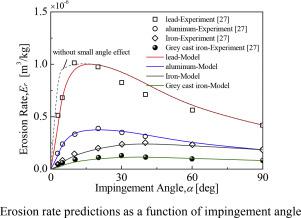当前位置:
X-MOL 学术
›
Powder Technol.
›
论文详情
Our official English website, www.x-mol.net, welcomes your
feedback! (Note: you will need to create a separate account there.)
A new mechanistic model for abrasive erosion using discrete element method
Powder Technology ( IF 4.5 ) Pub Date : 2021-03-01 , DOI: 10.1016/j.powtec.2020.11.017 Yunshan Dong , Fengqi Si , Yue Cao , Wei Jin , Shaojun Ren
Powder Technology ( IF 4.5 ) Pub Date : 2021-03-01 , DOI: 10.1016/j.powtec.2020.11.017 Yunshan Dong , Fengqi Si , Yue Cao , Wei Jin , Shaojun Ren

|
Abstract In this investigation an approach to abrasion erosion prediction is developed with consideration of cutting and deformation mechanisms using the discrete element method (DEM). Erosion rate is divided into two parts, cutting and deformation, which are related to the indentation sizes that are predicted by DEM. Empirical coefficients, of course, are introduced to establish the relevance between erosion rate and indentation volume. The proposed model is validated against experiments and results show the model accurately predicts abrasive erosion, especially for the maximum erosion angle. Furthermore, empirical coefficients are deemed to have more associations with hardness ratio H ˜ , and their relevance and influence on erosion are discussed. Cutting removal has a 2.0–2.7 power-law relation with particle velocity and deformation damage removal has a 2.8 power-law relation for H ˜ H ˜ >0.15. Finally, the universal correlation with empirical coefficients is integrated to the proposed model, which makes advances in the industrial application.
中文翻译:

一种基于离散元法的磨料侵蚀新机理模型
摘要 在这项研究中,开发了一种磨损侵蚀预测方法,同时考虑了使用离散元方法 (DEM) 的切割和变形机制。侵蚀率分为切割和变形两部分,这与 DEM 预测的压痕尺寸有关。当然,引入经验系数是为了建立侵蚀率和压痕体积之间的相关性。所提出的模型经过实验验证,结果表明该模型准确地预测了磨料侵蚀,尤其是对于最大侵蚀角度。此外,经验系数被认为与硬度比 H ~ 有更多的关联,并讨论了它们的相关性和对侵蚀的影响。切割去除率有 2.0–2。7 与粒子速度和变形损伤去除的幂律关系对于 H ~ H ~ >0.15 具有 2.8 的幂律关系。最后,将与经验系数的普遍相关性整合到所提出的模型中,这在工业应用中取得了进展。
更新日期:2021-03-01
中文翻译:

一种基于离散元法的磨料侵蚀新机理模型
摘要 在这项研究中,开发了一种磨损侵蚀预测方法,同时考虑了使用离散元方法 (DEM) 的切割和变形机制。侵蚀率分为切割和变形两部分,这与 DEM 预测的压痕尺寸有关。当然,引入经验系数是为了建立侵蚀率和压痕体积之间的相关性。所提出的模型经过实验验证,结果表明该模型准确地预测了磨料侵蚀,尤其是对于最大侵蚀角度。此外,经验系数被认为与硬度比 H ~ 有更多的关联,并讨论了它们的相关性和对侵蚀的影响。切割去除率有 2.0–2。7 与粒子速度和变形损伤去除的幂律关系对于 H ~ H ~ >0.15 具有 2.8 的幂律关系。最后,将与经验系数的普遍相关性整合到所提出的模型中,这在工业应用中取得了进展。











































 京公网安备 11010802027423号
京公网安备 11010802027423号